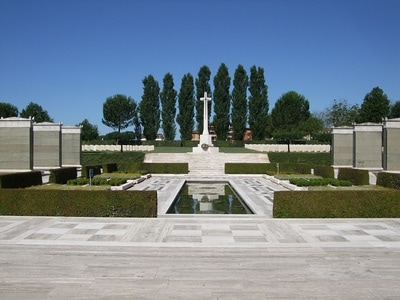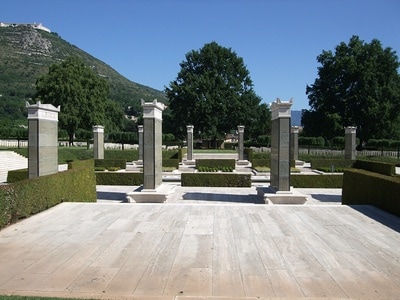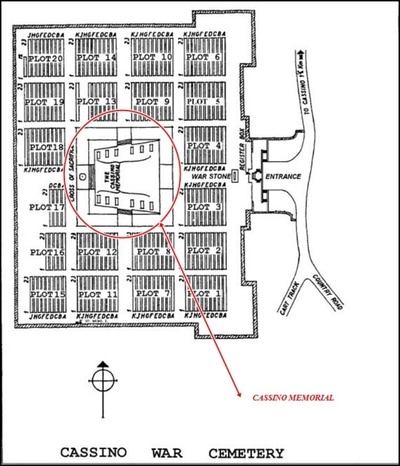CASSINO MEMORIAL
Frosinone
Italy
Location Information
Cassino War Cemetery lies in the Commune of Cassino, Province of Frosinone, 139 kilometres south-east of Rome.
Take the autostrada A1 from Rome to Naples and leave it at the Cassino exit. Take the roundabaout and take the third exit and follow the road signs to Cassino. On this roa you will find the first of 6 clearly visible signposts to the cemetery and memorial.
The cemetery is located approximately 1 kilometre from the railway station in Via Sant Angelo and visitors arriving by train are advised to take a taxi from the station.
Visiting Information
Opening times:
Winter: 8.00am -12.00pm & 1.00pm -3.30pm
Summer: 7.30am -12.00pm & 1.00pm - 4.00pm
Due to regular theft and damage to the Memorial Register and Visitors Book, they are accessible only during the hours when the gardeners are present(as stated above).
There has been incidents of car thefts around the area therefore visitors are advised to lock their vehicles and to not leave any belongings unattended.
Wheelchair access to the cemetery is possible via an alternative entrance.
Historical Information
On 3 September 1943 the Allies invaded the Italian mainland, the invasion coinciding with an armistice made with the Italians who then re-entered the war on the Allied side.
Progress through southern Italy was rapid despite stiff resistance, but by the end of October, the Allies were facing the German winter defensive position known as the Gustav Line, which stretched from the river Garigliano in the west to the Sangro in the east. Initial attempts to breach the western end of the line were unsuccessful. Operations in January 1944 landed troops behind the German lines at Anzio, but defences were well organised, and a breakthrough was not actually achieved until 18 May, when Cassino was finally taken.
The site for CASSINO WAR CEMETERY was originally selected in January 1944, but the development of the battle during the first five months of that year made it impossible to use it until after the Germans had withdrawn from Cassino. During these early months of 1944, Cassino saw some of the fiercest fighting of the Italian campaign, the town itself and the dominating Monastery Hill proving the most stubborn obstacles encountered in the advance towards Rome. The majority of those buried in the war cemetery died in the battles during these months.
There are now 4,266 Commonwealth servicemen of the Second World War buried or commemorated at Cassino War Cemetery. 284 of the burials are unidentified.
Within the cemetery stands the CASSINO MEMORIAL which commemorates over 4,000 Commonwealth servicemen who took part in the Italian campaign and whose graves are not known. The Memorial was designed by Louis de Soissons and unveiled by Field Marshal The Rt. Hon. The Earl Alexander of Tunis on 30 September 1956.
Cassino War Cemetery lies in the Commune of Cassino, Province of Frosinone, 139 kilometres south-east of Rome.
Take the autostrada A1 from Rome to Naples and leave it at the Cassino exit. Take the roundabaout and take the third exit and follow the road signs to Cassino. On this roa you will find the first of 6 clearly visible signposts to the cemetery and memorial.
The cemetery is located approximately 1 kilometre from the railway station in Via Sant Angelo and visitors arriving by train are advised to take a taxi from the station.
Visiting Information
Opening times:
Winter: 8.00am -12.00pm & 1.00pm -3.30pm
Summer: 7.30am -12.00pm & 1.00pm - 4.00pm
Due to regular theft and damage to the Memorial Register and Visitors Book, they are accessible only during the hours when the gardeners are present(as stated above).
There has been incidents of car thefts around the area therefore visitors are advised to lock their vehicles and to not leave any belongings unattended.
Wheelchair access to the cemetery is possible via an alternative entrance.
Historical Information
On 3 September 1943 the Allies invaded the Italian mainland, the invasion coinciding with an armistice made with the Italians who then re-entered the war on the Allied side.
Progress through southern Italy was rapid despite stiff resistance, but by the end of October, the Allies were facing the German winter defensive position known as the Gustav Line, which stretched from the river Garigliano in the west to the Sangro in the east. Initial attempts to breach the western end of the line were unsuccessful. Operations in January 1944 landed troops behind the German lines at Anzio, but defences were well organised, and a breakthrough was not actually achieved until 18 May, when Cassino was finally taken.
The site for CASSINO WAR CEMETERY was originally selected in January 1944, but the development of the battle during the first five months of that year made it impossible to use it until after the Germans had withdrawn from Cassino. During these early months of 1944, Cassino saw some of the fiercest fighting of the Italian campaign, the town itself and the dominating Monastery Hill proving the most stubborn obstacles encountered in the advance towards Rome. The majority of those buried in the war cemetery died in the battles during these months.
There are now 4,266 Commonwealth servicemen of the Second World War buried or commemorated at Cassino War Cemetery. 284 of the burials are unidentified.
Within the cemetery stands the CASSINO MEMORIAL which commemorates over 4,000 Commonwealth servicemen who took part in the Italian campaign and whose graves are not known. The Memorial was designed by Louis de Soissons and unveiled by Field Marshal The Rt. Hon. The Earl Alexander of Tunis on 30 September 1956.
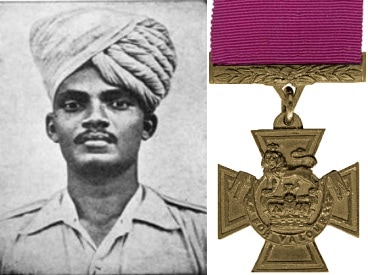
9192 Naik Yashwant Ghatge, V. C.
3rd Bn. 5th Mahratti Light Infantry, died 10th July 1944, aged 23. Panel 17.
Son of Vithabai; husband of Laxmibai, of Palasgaon (Amnechiwadi), Kolaba, India.
Citation: The citation in the London Gazette for 2nd November, 1944, gives the following details:- In Italy, on 10th July 1944, a company of the 5th Mahratta Light Infantry attacked a position strongly defended by the enemy. A rifle section commanded by Naik Yashwant Ghatge came under heavy machine-gun fire, which killed or wounded all the section except the commander. Without hesitation, Naik Yashwant Ghatge rushed the machine-gun post. He threw a grenade, shot one of the crew, and then, grasping his gun by the barrel, killed the remaining two men. Finally he was shot by enemy snipers and died in the post which he had captured single-handed. The courage, determination, and devotion to duty of this Indian N.C.O. in a situation where he knew the odds against him gave little hope of survival were outstanding.
3rd Bn. 5th Mahratti Light Infantry, died 10th July 1944, aged 23. Panel 17.
Son of Vithabai; husband of Laxmibai, of Palasgaon (Amnechiwadi), Kolaba, India.
Citation: The citation in the London Gazette for 2nd November, 1944, gives the following details:- In Italy, on 10th July 1944, a company of the 5th Mahratta Light Infantry attacked a position strongly defended by the enemy. A rifle section commanded by Naik Yashwant Ghatge came under heavy machine-gun fire, which killed or wounded all the section except the commander. Without hesitation, Naik Yashwant Ghatge rushed the machine-gun post. He threw a grenade, shot one of the crew, and then, grasping his gun by the barrel, killed the remaining two men. Finally he was shot by enemy snipers and died in the post which he had captured single-handed. The courage, determination, and devotion to duty of this Indian N.C.O. in a situation where he knew the odds against him gave little hope of survival were outstanding.
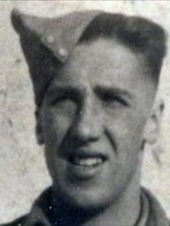
14408063 Private
Arthur Ralph Glew
2nd/7th Bn. The Queen's Royal Regiment (West Surrey)
21st January 1944, aged 21.
Panel 4.
Son of Arthur and Florence Glew, of Leicester.
In memory of an uncle, brother and a dear cousin, Eric Lewis (War Veteran)
Arthur Ralph Glew
2nd/7th Bn. The Queen's Royal Regiment (West Surrey)
21st January 1944, aged 21.
Panel 4.
Son of Arthur and Florence Glew, of Leicester.
In memory of an uncle, brother and a dear cousin, Eric Lewis (War Veteran)
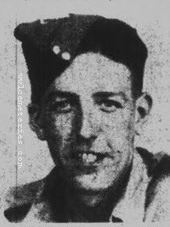
14394988 Lance Corporal
William Joll
2nd Bn. The King's Regiment (Liverpool)
12th May 1944, aged 30.
Panel 5.
Son of Mr. and Mrs. John Henry Joll, of Burnley, Lancashire; husband of M. Joll, of Burnley.
William Joll
2nd Bn. The King's Regiment (Liverpool)
12th May 1944, aged 30.
Panel 5.
Son of Mr. and Mrs. John Henry Joll, of Burnley, Lancashire; husband of M. Joll, of Burnley.
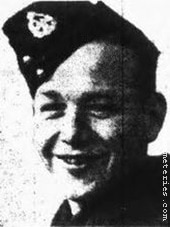
3387940 Corporal
Edward Shackleton
2nd Bn. The King's Regiment (Liverpool)
12th May 1944, aged 25.
Panel 5.
Son of Herbert and Lottie Shackleton; husband of Margaret Shackleton, of Burnley, Lancashire.
Edward Shackleton
2nd Bn. The King's Regiment (Liverpool)
12th May 1944, aged 25.
Panel 5.
Son of Herbert and Lottie Shackleton; husband of Margaret Shackleton, of Burnley, Lancashire.

